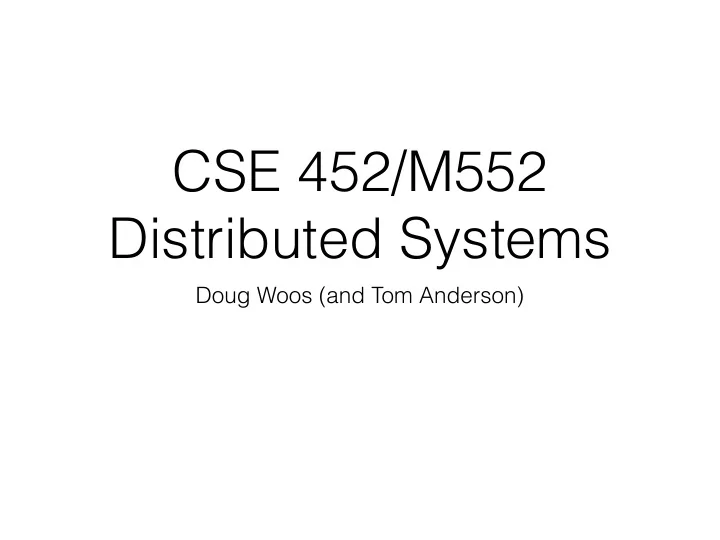

CSE 452/M552 Distributed Systems Doug Woos (and Tom Anderson)
About me I’m Doug, one of Tom’s students Mostly using Tom’s materials Work on distributed systems verification He/him or they/them
Logistics Course website - Important: Office Hours (none today) Piazza Code word is “leopard”: http://tinyurl.com/m9eg43b Names
Place in Curriculum CSE 333: Systems Programming - Projects in C++ - How to use the OS interface CSE 451: Operating Systems - How to make a single computer work reliably - How an operating system works internally CSE 452: Distributed Systems - How to make a set of computers work reliably and efficiently, despite failures of some nodes
Related courses CSE 461: Computer Communication Networks - How to connect computers together - Networks are a type of distributed system CSE 444: Database System Internals - How to store and query data, reliably and efficiently - Mostly single-node databases CSE 550: Systems For All - One quarter firehose version of 451/452/461/444 - Mostly PhD students
Thought experiment Imagine a group of people, two of whom have green dots on foreheads Without using a mirror or communicating, can anyone tell if they have a green dot? What if I say: someone has a green dot
What you know vs. What you know others know
Distributed systems Multiple connected nodes that cooperate in performing a task or providing a service - Examples?
Why distributed systems? Communicate across geographic separation - Locality is super important Ensure availability - Whole system shouldn’t fail when one node fails Aggregate systems for higher capacity - Nodes fail all the time - Whole system shouldn’t fail when one node does
Why are distributed systems cool*? Extremely important in practice - Crucial to bottom-line of huge companies - Crucial to the daily lives of many users Rich, well-studied theory - Long tradition of formal reasoning - Neat mathematical results * For some values of “cool”
Why are distributed systems hard? Asynchrony - Different nodes run at different speeds - Messages can be unpredictably, arbitrarily delayed Failures (partial and ambiguous) - Parts of the system can crash - Can’t tell crash from slowness Concurrency and consistency - Replicated state, cached on multiple nodes - How to keep many copies of data consistent?
Why are distributed systems hard? Performance - Have to efficiently coordinate many machines - Performance is variable and unpredictable - Tail latency: only as fast as slowest machine Testing and verification - Almost impossible to test all failure cases - Proofs (emerging field) are really hard Security - Need to assume adversarial nodes
Sense of scale Wide-area matters (across continents) Local-area also matters (within a data center) Correctness is the same - Have to account for failures either way Performance is different
Prineville Data Center Huge FB data center in Oregon Contents: - 200K+ servers - 500K+ disks - 10K network switches - 300K+ network cables How likely is it that everything is functioning at once?
MTTF/MTTR Mean Time to (Failure/Repair) Disk failures per year: 20% or so - So like 2/hour - Takes about an hour to restore If each server reboots once/month - 30s reboot -> 5 mins/year offline - 500K mins/year -> ~2 rebooting … and not all of FB’s servers are in Oregon
Local vs. Remote Operations How long to do a procedure call locally? - 10 instructions How about to another node in the same DC? How about to a node in some other DC? - Speed of light = 1ft/ns
Properties we want Fault-tolerant (Lab 2) - Doesn’t go wrong when components fail Highly available (Lab 3) - Doesn’t go down when components fail Scalable (Lab 4) - Can grow to more (nodes, memory, etc.)
Other properties we want Consistent (All labs) - Appears as one node Predictable performance - Consistently stays within SLAs Secure (Week 9) - Can grow to more (nodes, memory, etc.) Guaranteed Correct (Week 10) - Formally proven to follow spec
Labs Implement a sharded, replicated key-value store - Lab 1: MapReduce - Lab 2: Primary/backup - Lab 3: Paxos - Lab 4: Sharding In Golang - New-ish language, developed at Google - “Easy” to learn, “easy” to write concurrent code
Labs The labs are hard - Based on MIT’s grad-level course - Nontrivial for me, TAs, Tom General tips - Start early - Think before you code - Ask for help! (classmates, us, Piazza) Good candidates for code portfolio
Readings and blogs No good textbook in this area ~14 papers (first one this Wednesday) - “How to read a paper,” Keshav 2007 Blog - For 5 papers, write a short, unique thought (2-3 sentences) on the discussion board
Problem sets 5 problem sets - First one due in 3 weeks, out next Friday - To be done individually - Short answer questions - Should be quick (< 1 hour)
Another thought experiment Two generals have to coordinate a time to attack Messengers can be killed, arbitrarily detained No other communication If either attacks alone, army will be destroyed Design a protocol to coordinate an attack
Recommend
More recommend